1. Introduction
 Mushkin was founded in 1994. It has been active in the memory market and is one of the better known manufacturers in the overclocking community as well as with most users interested in pushing their systems to the limits, who choose Mushkin memory modules because of their quality and performance.
Mushkin was founded in 1994. It has been active in the memory market and is one of the better known manufacturers in the overclocking community as well as with most users interested in pushing their systems to the limits, who choose Mushkin memory modules because of their quality and performance.
The eXtreme Performance 512M XP2-6400 module (DDR2-800) offers second generation enhanced memory throughput and stability for the most extreme DDR2 computing platforms. A product of Mushkin's exclusive EPIC (Enhanced Performance IC) selection process, the XP2-6400 is hand-tested to the highest quality and performance standards.

The module is an unbuffered 240-Pin Double Data Rate x2 (DDR2) Synchronous DRAM Dual In-Line Memory Module (DIMM), organized as a single-bank, 64Mx64 high speed memory array using 64Mx8 chip density. This DIMM achieves high-speed data transfer rates of 800MHz at latencies of 4-4-3-10 (CAS-TRCD-TRP-TRAS).
The XP2-6400 is enhanced by Mushkin's Frostbyte heatspreader to ensure superior thermal performance and system reliability. With extreme performance and Mushkin's renowned reliability, the XP2-6400 is the memory upgrade of choice for those DDR2 enthusiasts demanding more out of their high-performance system.
It is fact that the industry is moving towards DDR2 memory. The largest slice of the market belongs to Intel and AMD based systems. Until now however, only Intel has supported DDR2 memory while AMD, is about to release its new platform with DDR2 support. As a result, most memory manufacturers have already started to offer higher memory speeds with lower timings.
We received Mushkin's XP2-6400 dual channel kit of 2x512MB, for our review.
The new XP2-6400 memory has the aluminium heatspreaders, a trademark of Mushkin modules, which help in heat dissipation and allow for greater ventilation. Notice the gap, shown in the screenshot below, between the memory chips and the heatspreaders.


The new XP2-6400 is available in both 512MB and 1GB memory modules, and is rated at 4-4-3-10 at 1.9V.
- Specifications
Frequency : 800MHz
Latency : 4-4-3-10
Voltage : 1.9V-2.1V
Module : 64Mx64
Parity : Unbuffered
Pins : 240
Chip : 64Mx8

2. Test System - Configuration
In order to test the new XP2-6400 dual channel kit of 2x512MB2x1GB modules, we used our ASUS motherboard, the P5WD2-E Premium, based on the Intel 975X chipset, and the Intel Pentium 4 Extreme Edition 3.73GHz processor. Below are some screen shots from CPU-Z v1.33.1.




The memory, according to Mushkin, is capable of running at 800MHz with CL 4-4-3-10 timings. The first measurements were taken with the modules set according to SPD.
- SPD
Serial Presence Detect (SPD) is information that describes the memory module's size, data width, speed, and voltage, and is stored on the memory module itself. When your computer boots up, the BIOS uses this information to configure the installed memory at maximum reliability and performance. This is also convenient for ordinary, everyday users, who may not want to be bothered with or don't know how to set the memory timings. If the timings are not set correctly, the computer may not start up at all or can cause exception errors in the operating system.
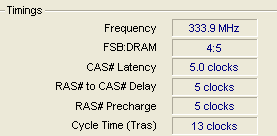
- 800MHz CL 4-4-3-10
We also set the memory to its certified speed and timings, according to Mushkin, which is 800MHz and CL 4-4-3-10.
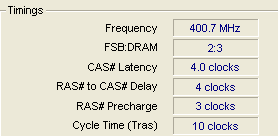
- 930MHz CL 4-4-3-10
Finally, we tried to reach the limit for this memory, without changing the timings. By overclocking the CPU, we could set the memory to 930MHz!

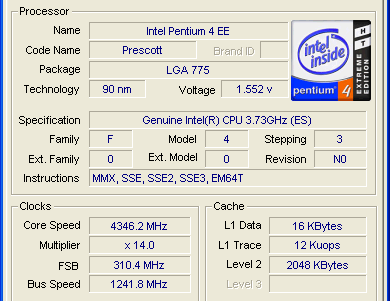
The memory can also run at 1000MHz or even at 1050MHz, with looser timings, of course. As we can see, the modules can definitely fullfil the needs of just about every type of user.


Here's a rundown of our testbed:
System Specifications
CPU: Intel Pentium 4 ED 3.73GHz
Cooler: Thermaltake Blue Orb II
Case: none
Motherboard: Asus P5WD2-E PREMIUM
Power supply: Thermaltake PurePower 520W
Memory: Mushkin XP2-6400 2x512MB Dual Channel
VGA: ASUS EAX1600XT Silent
Hard Disk Drive: WD800JD 80GB 7200RPM
OS: Windows XP Pro SP2
Drivers: Catalyst 6.4
DirectX: v9.0c
Benchmarks & Applications used
Memtest86+-1.65
Sisoft Sandra 2005
PcMark05
Performance Test V5.0 ( PassMark)
Half Life 2 - VST
CPU-Z v1.33.1
3. SiSoftware Sandra 2005
 SiSoftware Sandra is a 32 and 64-bit Windows system analyser that includes benchmarking, testing and listing modules. It tries to go beyond other utilities to show you more of what is really going on under the hood so you draw comparisons at both a high and low-level in a single product.
SiSoftware Sandra is a 32 and 64-bit Windows system analyser that includes benchmarking, testing and listing modules. It tries to go beyond other utilities to show you more of what is really going on under the hood so you draw comparisons at both a high and low-level in a single product.
You can get information about the CPU, chipset, video adapter, ports, printers, sound card, memory, network, Windows internals, AGP, ODBC Connections, USB2, Firewire etc.
You can save/print/fax/e-mail/post/upload or insert into ADO/ODBC databases reports in text, HTML, XML, SMS/DMI or RPT format.
This version supports multiple sources of information gathering including: remote computers, PDAs, Smart Phones, ADO/ODBC databases or saved system reports.
All benchmarks are optimised for both SMP & SMT (Hyper-Threading), up to 32/64 CPUs depending on the platform.
Memory Bandwidth Benchmark
Tests how your memory sub-system compares to other systems with the same or similar memory in other systems. The benchmark is based on the well-known STREAM memory bandwidth benchmark. (Higher is better, i.e. better performance).
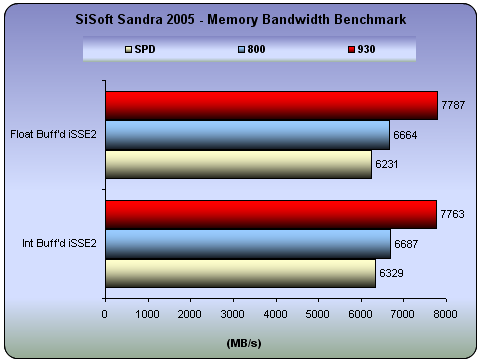
Even if you don't want to overclock your system, at least set the memory to its certified speed and timings. This will dramatically improve performance. And an overclocking profile, will increase it even further.
Cache & Memory Benchmark
Tests how your CPU cache and memory sub-system(s) compares to other systems with the same or similar CPU & memory in other systems. The benchmark is based on the Memory Bandwidth Benchmark test.
Combined Index: is a composite figure representing the overall performance rating of the entire Cache-Memory performance in terms of MB/s. The value is the logarithmic average of all the results for the entire address space. (Higher is better, i.e. better performance)
For block sizes that could not been tested - the average of previous blocks is used, thus the size of the memory (as long as it is not comparable to largest cache size) is not significant; all cache sizes are significant - larger caches will result in a higher index.

Speed Factor: is a figure representing the speed differential between the CPU’s cache and memory. The value is the ratio of the fastest cache (i.e. L1) bandwidth to the main memory bandwidth. (Lower is better, i.e. the memory is not very much slower than the CPU’s cache).
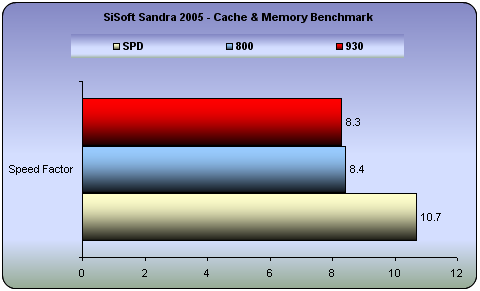
Definitely better results with the memory set at certified timings. SPD, while a safe choice, is a waste of processing power and is not recommended. Simply look at the difference in performance at 930Mhz or even 800 MHz, for both the combined index and speed factor benchmarks. It is huge.

4. PCMark05
PCMark05 is an application-based benchmark and a premium tool for measuring overall PC performance. It uses portions of real applications instead of including very large applications or using specifically created code. This allows PCMark05 to be a smaller installation as well as to report very accurate results. As far as possible, PCMark05 uses public domain applications whose source code can be freely examined by any user.

PCMark05 includes 4 categorized suites for benchmarking your computer. These include CPU, Graphics, Memory and a Hard Disk Drive benchmark. In our case, we selected to run only the Memory test suite.

| PCMark05 Memory Test |
SPD |
800 |
930 |
| Memory Read 16MB (MB/s) |
7306.975 |
7870.853 |
9155.581 |
| Memory Read 8MB (MB/s) |
7640.069 |
8250.617 |
9562.420 |
| Memory Read 192KB (MB/s) |
29551.939 |
29499.109 |
34308.367 |
| Memory Read 4KB (MB/s) |
49279.879 |
49292.688 |
57311.773 |
| Memory Write 16MB (MB/s) |
5347.788 |
5349.348 |
6225.532 |
| Memory Write 8MB (MB/s) |
5338.596 |
5366.637 |
6251.236 |
| Memory Write 192KB (MB/s) |
12591.624 |
12623.949 |
14688.365 |
| Memory Write 4KB (MB/s) |
12611.517 |
12625.248 |
14698.829 |
| Memory Copy 16MB (MB/s) |
5165.882 |
5772.209 |
6702.497 |
| Memory Copy 8MB (MB/s) |
5157.440 |
5745.736 |
6683.738 |
| Memory Copy 192KB (MB/s) |
10439.039 |
10412.646 |
12135.092 |
| Memory Copy 4KB (MB/s) |
12625.459 |
12627.254 |
14682.036 |
| Memory Latency 16MB (MAccesses/s) |
9.380 |
10.903 |
12.680 |
| Memory Latency 8MB (MAccesses/s) |
9.977 |
11.361 |
13.354 |
| Memory Latency 192KB (MAccesses/s) |
159.396 |
159.409 |
185.266 |
| Memory Latency 4KB (MAccesses/s) |
934.300 |
934.313 |
1085.830 |
Better overall performance with the manufacturer's recommended speed and timings, but even higher with the overclocked settings at 930MHz.

5. Performance Test v5.0
 Passmark PerformanceTest is an award winning PC hardware benchmark utility that allows everybody to quickly assess the performance of their computer and compare it to a number of standard 'baseline' computer systems.
Passmark PerformanceTest is an award winning PC hardware benchmark utility that allows everybody to quickly assess the performance of their computer and compare it to a number of standard 'baseline' computer systems.
Twenty seven standard benchmark tests are available in seven test suites plus there are five advanced testing windows for custom benchmarking. CPU Tests, 2D Graphics Tests, 3D Graphics Tests, Disk Tests, Memory Tests and CD/DVD Tests. In our case we selected the Memory suite Tests.
- Memory Benchmarks
This suite contains a number of tests that exercise the memory sub-system of the computer. (Random Access Memory- RAM)
Memory - Allocate small block
This test measures the time taken to allocate & free small zeroed memory blocks (around 100KB block size)
Memory - Cached
This test measures the time taken to read a small block of memory. The block is small enough to be held entirely in cache (if one is present)
Memory - UnCached
This test measures the time taken to read a large block of memory. The block is too large to be held in cache.
Memory - Write
This test measures the time taken to write information into memory.
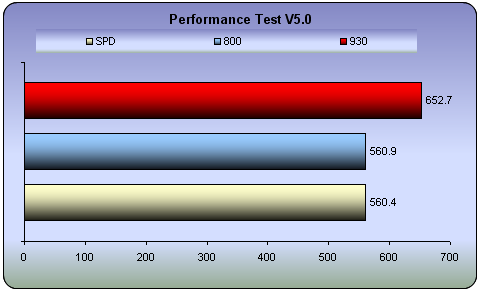
This is the only test that reported similar performance between SPD setup and recommended settings from Mushkin. No doubts however, that overclocking increases the overall performance.
- Advanced Memory Benchmark
Memory Speed Per Access Step Size
The first test type, ‘Memory Speed Per Access Step Size’ accesses a large block, of memory in various sized steps. First, it runs through the block of memory sequentially, accessing every value. Next it runs through the same block again, except this time it accesses every second value. On this occasion, it runs through the block twice in order to access the same amount of data as the initial step. Next it runs through the same block again, except this time it accesses every fourth value and so makes four passes. And so on, until a certain maximum step size is reached.
The size of the block of memory used for this test is one quarter the amount of system RAM. The size of the steps varies from 1 (continuous sequential access), to one quarter the size of the block of memory ( i.e. one sixteenth of the system RAM ).
| Memory Speed (MB/Sec. per Step Size) |
SPD |
800 |
930 |
| Block Read Speed |
39.18 |
41.18 |
47.92 |
| Block Write Speed |
24.67 |
27.52 |
32.07 |
Memory Speed Per Block Size
When a computer program wants to use a section of memory to store data, it makes a request to Windows for the amount of memory it requires. Windows allocates the memory to the program ( unless system resources are very low ) and returns to the requesting program the address of the first memory slot in the allocated block. It is possible that some programs may request very large amounts of memory. The ‘Memory Speed Per Block Size’ test like the ‘Memory Speed Per Access Step Size’ test, is composed of many steps. During each step of the test, PerformanceTest requests a block of memory and runs through the block measuring the average access time. However on each subsequent step the size of the requested memory is increased, until finally a block close to the size of the system RAM is requested. In this way it is possible to observe the different access speeds for the different sizes of blocks.
Typically it is possible to see very fast memory access for blocks which are small enough to fit entirely into the L2 RAM cache, and slower access times for larger blocks accessed from main RAM. In the case where system resources are low, swapping to the disk may even be required for very large blocks.
| Memory Speed (MB/Sec. per Block Size) |
SPD |
800 |
930 |
| Block Read Speed |
430.83 |
432.08 |
501.90 |
| Block Write Speed |
298.80 |
299.19 |
347.79 |
Again, there is huge gain when the memory is overclocked.

6. Half Life 2
 Half life 2 is no doubt the most anticipated PC game of all time.
Half life 2 is no doubt the most anticipated PC game of all time.
Physics - From pebbles to water to 2-ton trucks respond as expected, as they obey the laws of mass, friction, gravity, and buoyancy.
Graphics - Source's shader-based renderer, like the one used at Pixar to create movies such as Toy Story® and Monster's, Inc.®, creates the most beautiful and realistic environments ever seen in a video game.
AI - Neither friends nor enemies charge blindly into the fray. They can assess threats, navigate tricky terrain, and fashion weapons from whatever is at hand.
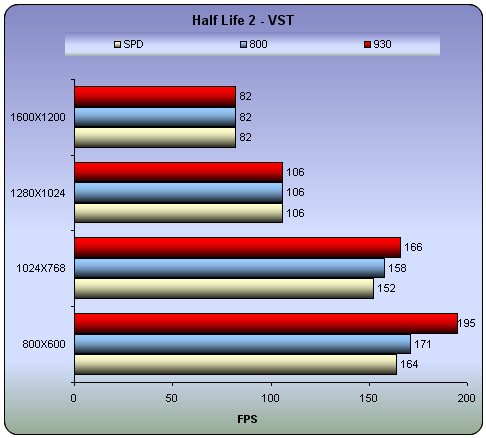
There also is a noticeable difference in games environments. As we previously mentioned, the recommended settings are a great step up from SPD. But overclocking is better as far as performance is concerned. It simply requires that the processor is running at a higher frequency. Higher resolutions demand more processing power from the graphics card and less from the rest of the system. It is for this reason that at 1280X1024 and 1600X1200, the framerates are the same, regardless of the memory setup.

7. Conclusion
The XP2-6400 memory is of very good design and quality. The black aluminium heatspreaders help heat dissipation while also allowing for better ventilation making for a more stable performance. This modules are very impressive when installed on any motherboard and they enhance the look of any system.
The performance depends on the settings, of course. We highly recommend setting the memory to its certified speed and timings, 800MHz and 4-4-3-10 respectively. Under SPD, the speed is 667MHz and CL 5-5-5-13. Why get 800MHz certified memory modules if you are going run them at 667MHz?
The overall performance at 800MHz/4-4-3-10 is good, but at 930/4-4-3-10 is absolutely great. In fact, with SiSoft Sandra 2005, the Mushkin XP2-6400 memory produced great scores of 7787MB/s and 7763MB/s in the Memory Bandwidth benchmarks, for the Floating Point and Integer maths benchmarks respectively. While in the Combined Index, the reported 13858MB/s is great also. In PCMar05, the 5856 PCMarks is an excellent score. The performance gets even better when the memory is set to 1050MHz. In this case, the Memory Bandwidth benchmarks increased up to 7926MB/s and 7909MB/s, while for the Combined Index, up to 14044MB/s, and finally PCMark05 went up to 5954.
In games, the recommended setting produced very good framerates, but again, increased memory speed in combination with an overclocked CPU will increase the framerate even more, where this is possible of course, since keep in mind that graphics is something that is highly dependent on the graphics card.

At the time of this review, the price for the XP2-6400 2x512MB was US$180, according to Mushkin. A very good price in combination with great performance and a lifetime warranty, makes this product a great buy.
